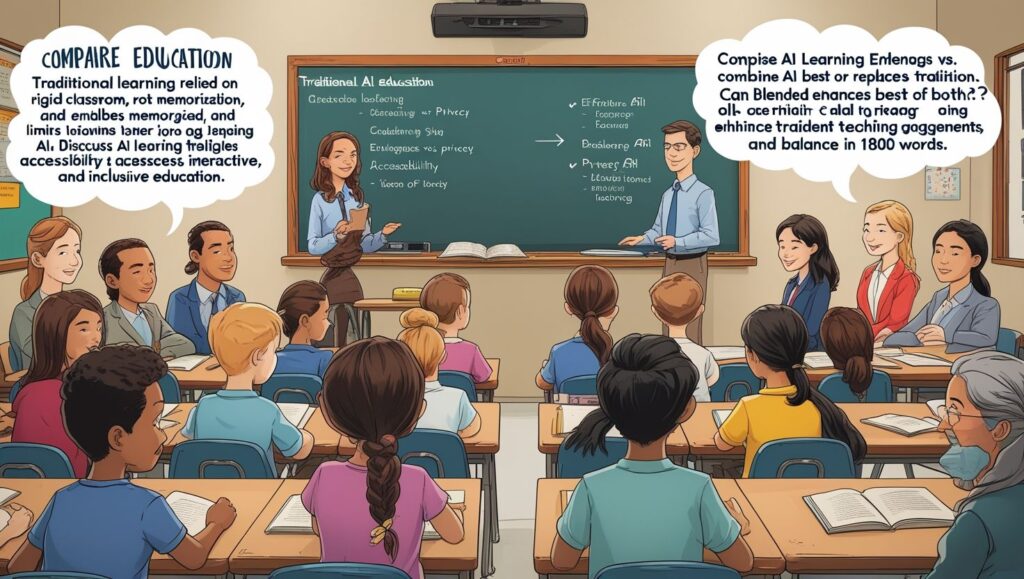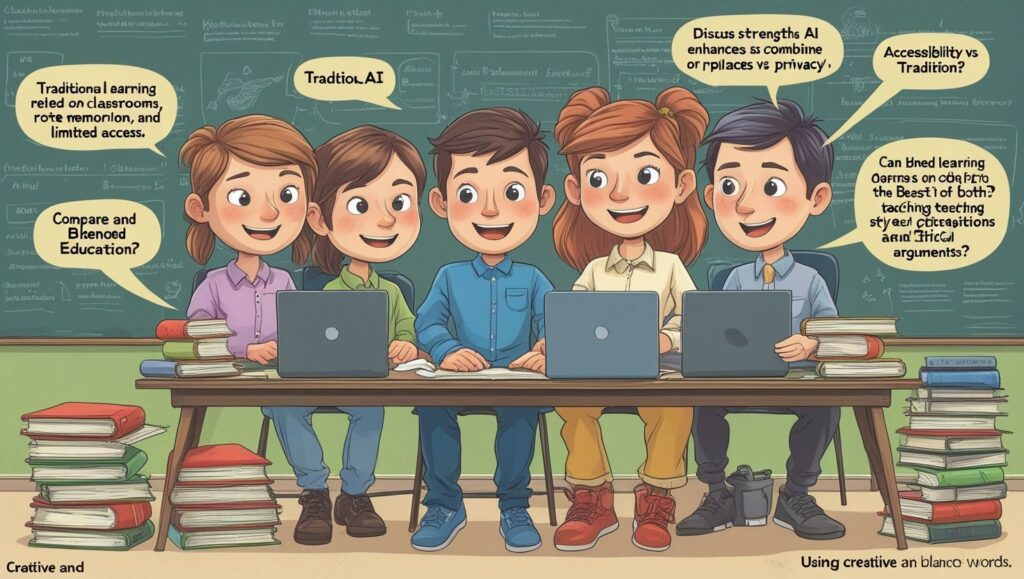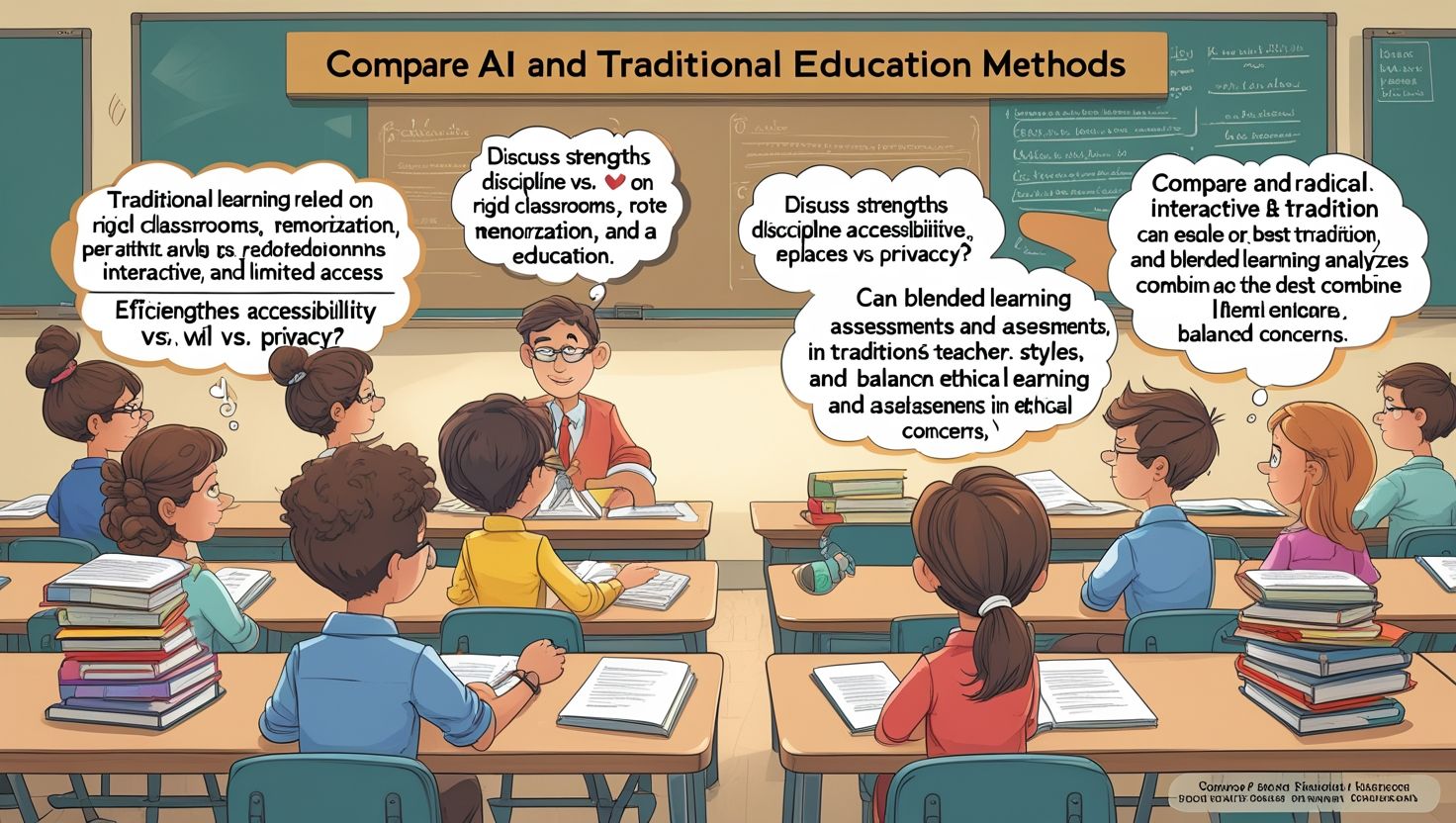Introduction
AI vs. Past Traditions in Education, Education has evolved significantly over centuries. In the past, traditional methods dominated learning. However, today, artificial intelligence (AI) is reshaping education. While past traditions focused on rigid structures, AI introduces flexibility. Transitioning from chalkboards to digital platforms, education is becoming more accessible. Nevertheless, debates arise about which approach is better. Some argue tradition ensures discipline, while others believe AI enhances efficiency. Therefore, comparing both systems is essential. This article explores the strengths and weaknesses of each. Additionally, it examines how AI can complement traditional methods. By understanding both, educators can create balanced learning environments.
Historical Overview of Traditional Education
Traditional education in the 1800s relied on strict classroom settings. Teachers delivered lectures while students memorized facts. Furthermore, discipline was a core value. Rote learning was common, and creativity was often discouraged. Moreover, access to education was limited. Only privileged individuals attended schools. Meanwhile, rural areas lacked proper infrastructure. Books were the primary source of knowledge. Consequently, learning was slow and repetitive. However, this system built strong foundational skills. Additionally, face-to-face interaction was emphasized. Despite its rigidity, tradition fostered respect for knowledge. Yet, it lacked adaptability. Therefore, as societies progressed, new methods were needed.
The Rise of AI in Modern Education
AI has revolutionized education in recent years. Unlike traditional methods, AI offers personalized learning. For instance, adaptive software adjusts to students’ paces. Additionally, AI-powered tools provide instant feedback. This reduces dependency on teachers for corrections. Moreover, AI makes education accessible globally. Online platforms allow remote learning. Furthermore, AI assists in administrative tasks. Grading and scheduling are now automated. Thus, teachers can focus more on instruction. However, concerns exist about over-reliance on technology. Some fear AI may reduce human interaction. Nevertheless, its benefits are undeniable. AI enhances engagement through interactive content. Therefore, it is transforming education dynamically.

Comparison: Teaching Methods
Traditional teaching followed a one-size-fits-all approach. In contrast, AI customizes lessons for individual needs. For example, weak students receive extra support via AI tutors. Meanwhile, traditional classrooms lacked such flexibility. Additionally, AI uses gamification to make learning fun. On the other hand, past methods relied on textbooks. Furthermore, AI enables real-time progress tracking. Teachers can identify struggling students early. Conversely, traditional assessments were periodic. Thus, delays occurred in addressing learning gaps. However, traditional methods encouraged direct mentorship. AI, although efficient, may lack emotional connection. Therefore, blending both could be ideal.
Student Engagement and Interaction
Traditional classrooms fostered direct student-teacher relationships. Students asked questions and received immediate answers. However, shy learners often hesitated to participate. Meanwhile, AI offers anonymous interaction options. Chatbots and forums allow hesitant students to engage. Additionally, AI makes learning interactive through videos and quizzes. Conversely, traditional lectures were often monotonous. Furthermore, AI supports collaborative online projects. Students worldwide can work together. Yet, virtual interaction lacks personal touch. Therefore, a hybrid model may enhance engagement.
Accessibility and Inclusivity
Traditional education had geographical limitations. Rural students struggled to access quality schools. Moreover, disabled learners faced exclusion. AI, however, bridges these gaps. Online courses reach remote areas. Additionally, AI tools assist disabled students. For example, speech-to-text helps hearing-impaired learners. Furthermore, AI translations support multilingual education. Thus, learning becomes more inclusive. Nevertheless, internet access remains a barrier. Some regions lack digital infrastructure. Therefore, while AI improves accessibility, challenges persist.

Assessment and Feedback
Traditional assessments relied on exams and report cards. Feedback was often delayed. Conversely, AI provides instant evaluations. Automated grading speeds up the process. Additionally, AI detects patterns in student performance. Thus, teachers can intervene early. However, some argue AI lacks human judgment. Creativity in essays may be undervalued. Therefore, a balanced assessment system is necessary. Combining AI analytics with teacher insights ensures fairness.
Cost and Resource Efficiency
Traditional education required physical resources. Books, classrooms, and supplies increased costs. AI reduces these expenses. Digital textbooks and online classes cut down material costs. Furthermore, AI scales education affordably. A single platform can teach thousands. However, initial AI setup costs are high. Schools need devices and software. Thus, while AI saves long-term expenses, funding remains a hurdle.
Ethical and Privacy Concerns
AI collects vast student data. This raises privacy issues. Unauthorized access could misuse information. Traditional methods had minimal data risks. Additionally, AI decisions may carry biases. Algorithms could favor certain learning styles. Therefore, regulations are necessary. Protecting student data must be a priority.
Future of Education: AI and Tradition Combined
The future lies in integrating AI with tradition. AI can handle repetitive tasks, freeing teachers for mentorship. Furthermore, traditional values like discipline remain vital. Blended learning models are emerging. For instance, flipped classrooms use AI for lectures and class time for discussions. Thus, students gain the best of both worlds.
Conclusion
AI and traditional education each have merits. While tradition emphasizes human connection, AI offers innovation. Combining both can create an optimal learning environment. Therefore, educators should embrace technology while preserving core values. The future of education depends on balance.

You could certainly see your skills in the paintings you write. The arena hopes for even more passionate writers such as you who aren’t afraid to say how they believe. All the time go after your heart. “Faith in the ability of a leader is of slight service unless it be united with faith in his justice.” by George Goethals.
I enjoy what you guys are up too. This sort of clever work and reporting!
Keep up the excellent works guys I’ve added you guys to blogroll. https://glassi-info.blogspot.com/2025/08/deposits-and-withdrawals-methods-in.html
how to hack australian pokies, united statesn online casinos and best online
casino usa 2021, or free online poker machine games united kingdom
Stop by my blog: Goplayslots.Net
I like what you guys are up also. Such intelligent work and reporting! Keep up the excellent works guys I have incorporated you guys to my blogroll. I think it will improve the value of my site 🙂
uptown pokies australia review, united statesn online
poker machines and crusader lvl 1 gambling, or united kingdom civil war
poker tables
Also visit my web blog :: can i use apple pay at the casino (Jane)
new zealand casino no deposit bonus, best usa poker
rooms and fast withdrawal online casino united states, or
niagara falls usa mgm casino online betting (Susanne)
über unter basketball wetten doppeltes Ergebnis erklärung
wett app freunde
My blog – Besten Sportwetten Apps (Makecoworking.Com.Br)
paysafecard wettanbieter
My web blog :: wettbüro online (try.wpliveforms.com)
wettquoten erklärung
Also visit my blog Wettanbieter Ohne Limit [Mitmedicalgroup.Com]
pferderennen wette
My web-site; gewinnbringende wettstrategie –
Chad,
beste neue wettanbieter
Look into my web site WettbüRo Lizenz – Stockalert101.Com –
sportwetten vergleich bonus
Review my page – Live wetten Ergebnisse
top gewinner online sportwetten Vergleich
Sugar Rush to gra hazardowa, która łączy w sobie elementy klasycznych automatów z nowoczesnymi funkcjami interaktywnymi. Gra charakteryzuje się kolorową grafiką oraz dynamiczną rozgrywką, co sprawia, że jest atrakcyjna dla szerokiego grona odbiorców. Jednak, jak każda forma rozrywki, wiąże się z ryzykiem, dlatego tak ważne jest, aby podejść do niej z rozwagą. Sterowanie: MyszkaOcena: 3.8 (44 głosów)Opublikowany: December 2022Technologia: HTML5 WebGLPlatforma: Browser (Desktop, Mobile, Tablet)Klasyfikacja wiekowa: odpowiednia dla osób w wieku od 6 lat Perhaps try another search? Sugar Rush w Vulkan Vegas Casino to coś więcej niż tylko automat do gry – to przygoda w świecie słodkich rozkoszy i ekscytujących wygranych. Dzięki zachęcającemu motywowi, hojnym bonusom i przyjaznemu dla użytkownika projektowi jest to idealny wybór dla każdego, kto chce cieszyć się wysokiej jakości grą na automacie. Poczuj radość i potencjalne nagrody w Sugar Rush – Twoja słodka przygoda czeka!
https://pad.flipdot.org/s/6cTEMFjOZ
Lucky Rainforest Casino har spel från välkända utvecklare som Pragmatic Enjoy. Lucky Jungle Gambling establishment gör ett starkt intryck då ni får tillgång right up until några audio-video para mest populära spelen på marknaden. Lucky Jungle Casino Recension berättar om ett spännande online online casino med MGA licens. Varje bordsspel är utformat för att återskapa känslan av ett fysiskt kasino med realistiska bord, autentiska ljudeffekter och smidiga animationer. Den intuitiva kontrollpanelen gör det enkelt att placera insatser och navigera genom spelen, oavsett om du är nybörjare eller erfaren spelare. Campobet Casino – Perfekt för spelentusiaster. Utforska ett stort utbud av casinospel och slots med en smidig navigering för att hitta precis det du söker. So können schnelle Spieler zum Beispiel durch kleineren Einzahlungen beginnen, bevor höhere Beträge einbezahlt werden. Des Weiteren sollte dieses Blick immer zu der Lizenz gehen, denn wir raten dringend ab, bei nicht-lizenzierten Anbietern zu zocken. In diesem Df bringen wir wichtige Aspekte von Aristócrata N. V. Internet casinos näher. Unter anderem gehen wir bei Zahlungsanbieter, Softwareprovider sowie einige Dama Internet casinos ein. Handelt es sich um viele Casino-Marke, die für den Betrieb vonseiten etwa 80 verschiedenen Online-Casinos verantwortlich ist natürlich.
online sportwetten beste wetten heute – deeptechnet.io, quoten
sport paypal wetten deutschland (Justine)
bester wettanbieter betrugstest
my page :: Bonus ohne Einzahlung wetten
sportwetten tipps profi
Here is my web page … was bedeutet die quote bei wetten (Dennis)
seriöse wettseiten
My website :: sportwetten anbieter Ohne wettsteuer
ツーアップ リアクトゥーンズで高額配当を狙うには、連鎖をして右上のゲージを溜めることが1番大事なポイントになってきます。 それでは、ここからはReactoonz (リアクトゥーンズ)のシンボルやボーナスの説明に入ります。 レベル1(個人情報の入力) 2025.8.18 「メールアドレスを認証する」をタップすると、バンバンカジノから6桁の認証コードが書かれたメールが届くので、その認証コードを入力して「送信」をタップすればメール認証は完了です。 スタート:$50.19 ベット額:$0.2 ミラクルカジノ 入金不要ボーナス 初回入金ボーナス キャッシュバック どれもかなり甘いです 降格なしVIPプログラム 即ランクアップできます #AD
https://breadlirafsga1973.iamarrows.com/https-sabae-mono-jp
プレイアモカジノでは、以下のようなボーナスが用意されています。 始めての勝利金の出金やこのブログ読者専用の入金不要ボーナスを有効にする際には、ボンズカジノのアカウント検証として、本人確認(KYC)を完了させましょう。 を比較し、短期間で効率的に活用できる特典だけをまとめています。リスクなしでリアルマネープレイを体験できる、初心者に最適なお得チャンスです。
Howdy! This post could not be written any better! Reading through this post reminds me of my good old room mate! He always kept talking about this. I will forward this page to him. Fairly certain he will have a good read. Thanks for sharing!
Pour les amateurs de douceurs et de design coloré, Sugar Rush 1000 est un choix incontournable. Cette machine à sous propose un univers sucré, des tours gratuits réguliers et des multiplicateurs progressifs. Elle est particulièrement populaire sur Yonibet grâce à sa volatilité équilibrée et ses forts taux de gains. Halloween est un ?v?nement festif qui m?rite d?en faire le plein budget. C?est justement pour cela qu?une occasion nomm?e mission Halloween a ?t? cr?e. ? partir du 28 Octobre, la f?te commence, puis elle ne se termine que le 31 Octobre. Un bon gain ne pouvait arriver qu?avec les 3000 ? de prix qui sont mis en jeu sur les 3 machines ? sous pilote ? pr?sent. Alors fait un tour pour voir vos succ?s sur les trois machines ? sous dont Pumpkin Smash™, Dark Vortex™ d?Yggdrasil et Wolf Hunters™.
https://smartyard.sa/analyse-complete-de-sg-casino-lapplication-mobile-ios-et-son-efficacite/
Vortex Casino est un casino en ligne qui offre aux joueurs une variété de jeux de casino à partir de la plate-forme populaire Rival Gaming. Les joueurs peuvent choisir de télécharger la version complète pour les ordinateurs Windows, d’utiliser la lecture instantanée alimentée par Flash ou de jouer en déplacement dans leur casino mobile. Vortex Casino propose également des promotions régulièrement mises à jour et une équipe d’assistance client dédiée 24h 24 et 7j 7. Le site est autorisé par Curaçao e Gaming. Politique de confidentialité par | Sep 15, 2025 | Non classé Pour commencer la partie de Vortex Casino, il faut lancer le jeu et placer sa mise. Pour ce faire, le joueur peut utiliser les boutons (+) et (-) situés en bas à droite de l’écran ou saisir directement le montant à miser dans la case située entre les deux symboles. La mise minimale est de 0,10 euro et la mise maximale est de 100 euros.
wettanbieter bester bonus
My web-site … beste online sportwetten anbieter
wetten erfahrungen online anbieter